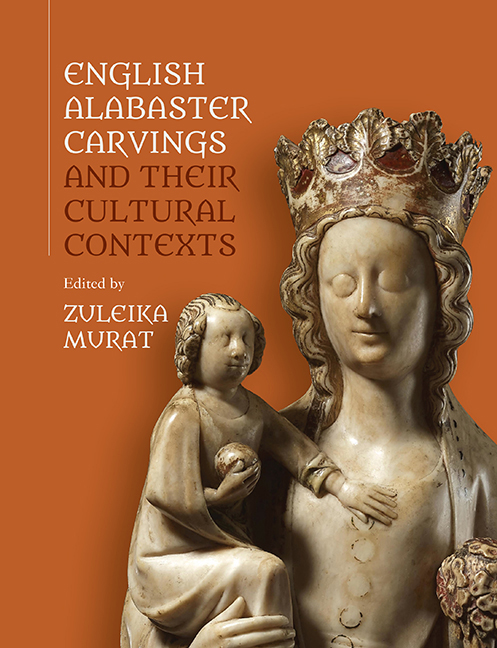Book contents
- Frontmatter
- CONTENTS
- List of Illustrations
- Acknowledgements
- List of Contributors
- Introduction
- 1 ‘Burton-Upon-Trent, Not Nottingham.’ the Evolving Study Of Medieval English Alabaster Sculpture
- 2 Stone to Ensure Victory and to Generate Friendships. On The Meaning of Alabaster
- 3 Contextualising English Alabasters in the Material Culture of the Medieval Mediterranean
- 4 English Alabaster Images As Recipients of Music in the Long Fifteenth Century: English Sacred Traditions in a European Perspective
- 5 Contextualising Alabasters in Their Immersive Environment. The ‘Ancona D'Allabastro Di Diverse Figure’ of the Novalesa Abbey: Meaning and Function
- 6 Alabaster Carvings in Late-Medieval Lincolnshire
- 7 ‘Tabernacles, Howsynges and Other Things’. Three Alabasters From the Burrell Collection in Context
- 8 Conservation Study of Three Alabaster Carvings From the Burrell Collection, Glasgow Museums
- 9 ‘Smooth as Monumental Alabaster’. the Alabaster Tomb Industry in England 1550–1660
- 10 Merchants’ Tombs in Alabaster
- 11 Exploring Alice: the Theological, Socio-Historical, and Anatomical Context of the De La Pole Cadaver Sculpture
- Bibliography
- Index
- Already Published
7 - ‘Tabernacles, Howsynges and Other Things’. Three Alabasters From the Burrell Collection in Context
Published online by Cambridge University Press: 14 September 2019
- Frontmatter
- CONTENTS
- List of Illustrations
- Acknowledgements
- List of Contributors
- Introduction
- 1 ‘Burton-Upon-Trent, Not Nottingham.’ the Evolving Study Of Medieval English Alabaster Sculpture
- 2 Stone to Ensure Victory and to Generate Friendships. On The Meaning of Alabaster
- 3 Contextualising English Alabasters in the Material Culture of the Medieval Mediterranean
- 4 English Alabaster Images As Recipients of Music in the Long Fifteenth Century: English Sacred Traditions in a European Perspective
- 5 Contextualising Alabasters in Their Immersive Environment. The ‘Ancona D'Allabastro Di Diverse Figure’ of the Novalesa Abbey: Meaning and Function
- 6 Alabaster Carvings in Late-Medieval Lincolnshire
- 7 ‘Tabernacles, Howsynges and Other Things’. Three Alabasters From the Burrell Collection in Context
- 8 Conservation Study of Three Alabaster Carvings From the Burrell Collection, Glasgow Museums
- 9 ‘Smooth as Monumental Alabaster’. the Alabaster Tomb Industry in England 1550–1660
- 10 Merchants’ Tombs in Alabaster
- 11 Exploring Alice: the Theological, Socio-Historical, and Anatomical Context of the De La Pole Cadaver Sculpture
- Bibliography
- Index
- Already Published
Summary
If fame were measured in photographs, the Burrell Collection's Head of St John the Baptist in a Tabernacle would be a celebrity (Inv. 1.34; Pl. X). Few objects have been reproduced as frequently or as generously in treatments of English alabasters or of St John's severed head. It has increasingly stolen the limelight from all other known examples and all but entirely eclipsed its two Glasgow fellows (Inv. 1.33 and 1.35; Pl. XI and Pl. XII). Yet this Head of St John in a “howsynge” has been a reluctant star. Its pre-museum life remains buried in the past. Many of the same ideas have been rehearsed again and again. This chapter sets out the state of research to date and looks at Burrell's trio of tabernacles afresh with a focus both on the central panels and on their wooden cases.
SIR WILLIAM - ST JOHN
Though it has usually been stated that Sir William Burrell (1861–1958) acquired his first English alabaster in 1900/1 in Paris, he probably began acquiring them in the 1890s. In 1944, he gave twenty-nine examples to Glasgow, complemented by a further nine, in 1948, 1949, 1951, and 1955. Burrell was competing with other voracious collectors, such as Walter Leo Hildburgh (1876–1955) and Philip Nelson (1872–1953). The tendency has been to see the Burrell Collection as exactly mirroring the collection that the Burrells assembled and enjoyed in their homes. Yet a closer reading of Sir William's meticulous purchase books begun in 1911 reveals that alabasters were occasionally returned or given to others. The tabernacles discussed here were acquired at fairly regularly spaced intervals.
The first of the group to be acquired was Inv. 1.34 (Pl. X). Published in 1920 as in Burrell's collection, this never-before-seen example does not appear in Burrell's notebooks, suggesting purchase before 1911. Philip Nelson clearly states that it goes back to George Grosvenor Thomas (1856–1923), an Australian artist-cum-dealer. Grosvenor Thomas was based in Glasgow between 1885/6 and 1899. Burrell is likely to have known him through his sales of paintings of the Barbizon and Hague Schools, or through his relationship with the Glasgow Boys002E
- Type
- Chapter
- Information
- English Alabaster Carvings and their Cultural Contexts , pp. 173 - 193Publisher: Boydell & BrewerPrint publication year: 2019



